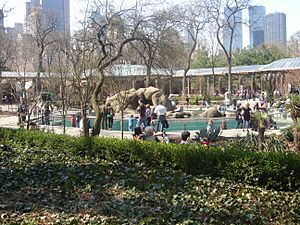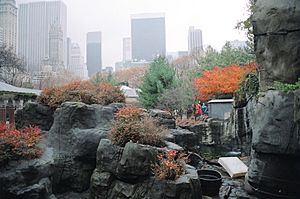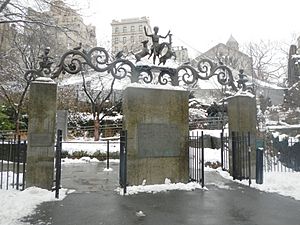Central Park Zoo facts for kids
Central Park Zoo logo
|
|

Central area of the Central Park Zoo
|
|
| Date opened |
|
|---|---|
| Location | Central Park, New York City, United States |
| Land area | 6.5 acres (2.6 ha) |
| Coordinates | 40°46′4″N 73°58′18″W / 40.76778°N 73.97167°W |
| Memberships | AZA |
The Central Park Zoo is a 6.5-acre zoo located in the southeast part of Central Park in New York City. It is part of a group of four zoos and one aquarium managed by the Wildlife Conservation Society (WCS). The WCS also runs educational programs for kids, helps save endangered animals, and works with the local community through volunteer programs.
The zoo started as a collection of animals in 1864. This was the first public zoo to open in New York. The current zoo first opened on December 2, 1934. It was part of a big plan to improve city parks, playgrounds, and zoos. The zoo was mostly built with help from government programs that created jobs during the Great Depression. A special Children's Zoo opened north of the main zoo in 1960.
After 49 years, the Central Park Zoo closed in 1983 for a big makeover. The old cages were replaced with natural-looking homes for the animals. The zoo reopened on August 8, 1988. It became part of the five facilities managed by the WCS. All these places are approved by the Association of Zoos and Aquariums (AZA).
Contents
Exploring the Central Park Zoo
The Central Park Zoo is part of the Wildlife Conservation Society (WCS). This group manages four zoos and an aquarium across New York City. The zoo is located at East 64th Street and Fifth Avenue. It covers about 6.5 acres inside Central Park. You can enter the zoo from Fifth Avenue or from inside Central Park.
The Central Park Zoo is a very popular spot in Central Park. More than a million people visit it every year. In 2016, the zoo had 1,487 animals from 163 different species.
Main Zoo Areas
The main zoo has three big exhibit areas: the Tropic Zone, the Temperate Territory, and the Penguins and Sea Birds section. These areas are connected by covered walkways with glass roofs. They are built around a central garden. In the middle of this garden is a square pool for sea lions. Glass fences around the pool let visitors watch the sea lions up close, especially during their daily feeding times.
Animal Exhibits and Buildings
The "Tropic Zone" is in the southwest corner of the central garden. It looks like a two-story tropical rainforest. Here, you can see animals like Rodrigues flying foxes, Seba's short-tailed bats, emerald tree boas, and pythons. There are also cotton-top tamarins, white-eared titis, toucans, and black-and-white ruffed lemurs. Many kinds of birds fly freely in this area, including scarlet ibises and superb starlings. You can also find red-bellied piranhas, pig-nosed turtles, and red-footed tortoises.
To the west of the garden is the "Temperate Territory." This area has paths around a lake. It is home to animals such as red pandas, white-naped cranes, Japanese macaques, and snow leopards. A special snow leopard exhibit opened here in June 2009.
The "Penguins and Sea Birds" section is on the north side of the garden. This building has a cool penguin house where you can see macaroni penguins, king penguins, and gentoo penguins. There are also Atlantic puffins and tufted puffins. Outside, there is a pool for harbor seals and an outdoor exhibit for grizzly bears.
The Arsenal building is next to the eastern side of the central garden. It was built in 1851 to store weapons. It used to be part of the zoo but now holds offices for the NYC Parks Department. The Central Park Zoo also has a 4D theater north of the Arsenal. A gift shop and ticket booth are south of the Arsenal.
The "Intelligence Garden" is on the south side of the garden. Its name comes from an old animal collection created by a Chinese king long ago. The Dancing Crane Cafe, a place to eat, is also located south of this garden.
Art and Conservation Efforts
You can find several artworks at the Central Park Zoo. Five buildings from the original 1934 zoo still have their animal-themed stone carvings by Frederick Roth. This artist also made two bronze statues, Dancing Goat and Dancing Bear, which are now at the zoo's southern entrance. Another old statue, Tigress and Cubs, was made in 1867 and moved to the zoo in 1934.
The zoo helps with breeding programs for endangered animals, like thick-billed parrots and red pandas. This is part of the Species Survival Plan. In 2011, the Central Park Zoo was the first zoo in North America to hatch ducklings of the very rare scaly-sided mergansers.
The zoo also offers educational programs. Volunteers lead tours for visitors and help with teaching programs. They go through a four-month training program. The zoo also has different programs for students.
Tisch Children's Zoo
The Children's Zoo is located north of the main zoo. It is officially called the Tisch Children's Zoo. This name honors businessman Laurence A. Tisch, whose donation helped pay for the zoo's renovation in the 1990s. The Children's Zoo has a petting zoo where you can meet mini Nubian goats, sheep, pigs, alpacas, and Patagonian cavies. It also has the only cow in Manhattan! There is also the Acorn Theatre, a place for performances. Your ticket to the main zoo includes admission to the Children's Zoo.
The Lehman Gates, designed by Paul Manship, are a special feature from the original Children's Zoo. They were given by Herbert and Edith Lehman in 1960. The Delacorte Clock, a gift from George T. Delacorte, was added in 1965. It is on a tower between the Wildlife Center and the Children's Zoo.
Zoo History
How the Zoo Started
Early Days and Growth
The Central Park Zoo was not part of the first plans for Central Park. However, people started giving exotic pets and other animals to the park. The first animal, a bear cub, was left in Central Park in 1859. Soon, people were donating other animals like cranes, peacocks, and goldfish. These animals became very popular with park visitors.
In 1862, about 60 acres were set aside for a future "zoological and botanical garden." In 1864, the zoo officially became a public zoo. This made it the second publicly owned zoo in the United States. By then, the park had over 400 animals.
Popularity and Challenges
The zoo became very popular because it was free to enter and easy to reach. By 1873, 2.5 million people visited each year. The first permanent zoo building was built in 1875. The zoo was most popular in the mid-1880s when a chimpanzee named "Mike Crowley" arrived. Many people, including former president Ulysses S. Grant, came to see the chimpanzee.
However, some people thought Central Park should be more about nature, not entertainment. By the 1890s, some wealthy residents wanted the zoo moved. This led to the creation of the Bronx Zoo in 1897, which was much larger. Even after the Bronx Zoo opened, the Central Park Zoo remained popular. In 1902, it attracted over three million visitors each year.
Over time, the zoo became run-down because the city government did not take good care of it. The zoo accepted all kinds of animals, even sick ones, but did not have enough vets. By 1932, the zoo was in very bad shape. Its 22 cages were described as "flimsy and rat-ridden." The wooden sheds were a fire danger, and the animal enclosures were so weak that zookeepers had to guard the lion house to stop lions from escaping.
The Modern Zoo
Building the New Zoo
In 1934, New York City Mayor Fiorello La Guardia hired Robert Moses to lead the Parks Department. Moses planned to rebuild the city's parks, including the zoo. He got a lot of money from government programs to create jobs during the Great Depression.
Plans for the new Central Park Zoo were quickly made in 1934. The plans called for nine new buildings made of brick and terracotta to replace the old ones. These included seven new animal homes, a restroom, and a garage. A sea lion pool was planned for the center of the new zoo. The new buildings were designed to be easy to keep clean.
The new zoo opened on December 2, 1934. By April 1936, six million people had visited the renovated zoo. A program was also started to get rid of rats in and around the zoo.
Changes in the 1960s and 1970s
In June 1960, Senator Herbert Lehman and his wife Edith donated money to build a new children's zoo. It opened on June 27, 1961. The children's zoo had a petting area with ducks, rabbits, and chickens. It also had a large fiberglass whale statue called "Whaley" that was the entrance.
In the late 1960s and early 1970s, the New York City Subway's 63rd Street lines were built right under the zoo. This subway tunnel became a meeting place for early graffiti artists. They called it Zoo York because it was in a zoo in New York.
By the mid-1970s, the Central Park Zoo was quite old and worn out. Protesters gathered outside the zoo in 1974 to complain about the conditions. Even so, the zoo was still one of the most popular attractions in Central Park.
1980s Renovation
In 1980, the city government and the New York Zoological Society (now the Wildlife Conservation Society, or WCS) agreed that the WCS would manage the Central Park Zoo. They planned to renovate the zoo in 1981. The plan was to tear down most of the old buildings around the sea lion pool and build new classrooms and a snack bar. Many people felt that keeping animals in small cages was wrong.
Starting in November 1982, the zoo's animals were temporarily moved to other zoos while construction was happening. Most of the large animals were moved permanently to the larger Bronx Zoo. The main zoo closed in late 1983.
The new zoo was designed by Kevin Roche. The old cages were replaced with three natural-looking habitats that fit in with Central Park's scenery. Four of the original buildings were kept, but the small outdoor cages were removed. The sea lion pool, a main feature of the old zoo, was kept.
The renovation cost $35 million and the zoo reopened on August 8, 1988. For the first time, the zoo started charging an admission fee. With the reopening, the WCS decided that the Central Park Zoo would focus on animal conservation.
1990s to Today
By the early 1990s, some parts of the Children's Zoo were falling apart. The city closed the zoo in 1991. With a $4.5 million gift from businessman Laurence A. Tisch, the Children's Zoo was renovated and reopened in September 1997 as the Tisch Children's Zoo.
In June 2009, the Allison Maher Stern Snow Leopard Exhibit opened. It cost $10.6 million and brought three snow leopards from the Bronx Zoo. This was the first new exhibit since the 1988 renovation. In March 2020, the Central Park Zoo closed temporarily due to the COVID-19 pandemic. It reopened in July of that year.
Famous Zoo Hoax
A well-known hoax about the zoo is called the Central Park Zoo escape or the Central Park menagerie scare of 1874. This was a trick played by James Gordon Bennett Jr. in his newspaper, the New York Herald. The newspaper's front page on November 9, 1874, claimed that many animals had escaped from the Central Park Zoo. It said that several people had been killed by the wild animals. The story said a rhinoceros escaped first, then a polar bear, a panther, a Numidian lion, several hyenas, and a Bengal tiger.
At the very end of the long article, there was a small note saying: "... of course, the entire story given above is a pure fabrication. Not one word of it is true." This was not enough to calm people down. Critics accused Bennett of causing panic. The writers later said they only wanted to show that the zoo's safety was not good enough. They were surprised by how much people reacted to their story.
Notable Animals at the Zoo
- In the early 1900s, Bill Snyder worked at the zoo. He bought Hattie, an Asian elephant, in 1920. Hattie passed away in 1922.
- Pattycake, a female western lowland gorilla, was born at the zoo in 1972. She was the first gorilla born in captivity in New York. She moved to the Bronx Zoo in 1982 and lived there until 2013.
- Gus, a male polar bear, lived at the zoo from 1988 until 2013. He had to be put to sleep because of a serious illness.
- Flaco, a Eurasian eagle owl, came to the zoo in 2010. Flaco escaped in 2023 when his home was damaged. He was found dead outside the park in 2024.
See also
 In Spanish: Zoológico de Central Park para niños
In Spanish: Zoológico de Central Park para niños



